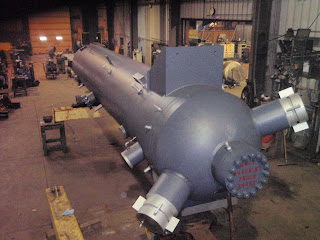I recently sent out the Abstract for my upcoming paper at the EPRI Feedwater Heater Technology Seminar and Conference August 7 - 8, 2013, in Kansas City, Kansas, USA.
The paper is titled High Pressure Feedwater Heater Cup Forging Alteration. I am co-authoring it with Bob Cashner and Sara Vestfals of American Electric Power (AEP).
Abstract
American Exchanger Services, Inc
performed a 2012 repair of a vertical head up High Pressure (HP) Feedwater
Heater breech lock channel during a shop based re-tube for the American
Electric Power (AEP) Wilkes Power Plant, Unit 1. The channel was a forged steel
cup-forging with up to 1-1/2” deep circumferential cracks extending radially into
the tight knuckle radius at the channel barrel to tubesheet junction. A small area was also found on the backside
of the tubesheet which had corroded to a depth of 7/16”.
Several methods to repair these
types of failures may be employed such as grinding out the crack and weld
repair, grinding or machining out the crack, or leaving as is and performing
regular inspections and monitoring of crack propagation. Using modern
calculations, a design was chosen that reduced the stresses in the highly
stressed corner radius. The alteration in design was to machine a pocket to fully
encompass the crack, verify tubesheet stresses are within allowable stress
limits, and prescribe future NDE to monitor for future cracking. The size of
the machined "pocket" was determined by the actual crack length "as
measured" and the repair was verified using Finite Element Analysis (FEA).
This repair was not a new method;
in fact it was researched by Electric Power Research Institute (EPRI) in 1988
symposium [1], based on an EPRI 1985 [2] similar repair. In this earlier repair
similar methods of Finite Element Analysis (FEA) were employed, however using less
sophisticated forms of the calculation. Modern computing allowed for 3D
analysis with more complex geometries, and more conservative meshing. The
analysis showed that the earlier papers had it correct in their understanding
of the problem and the proposed solutions. The important information was to
determine if the machined radius would reduce stresses sufficiently, which
would then allow the repair be within the NBIC [3] and ASME CODE [4]
requirements


